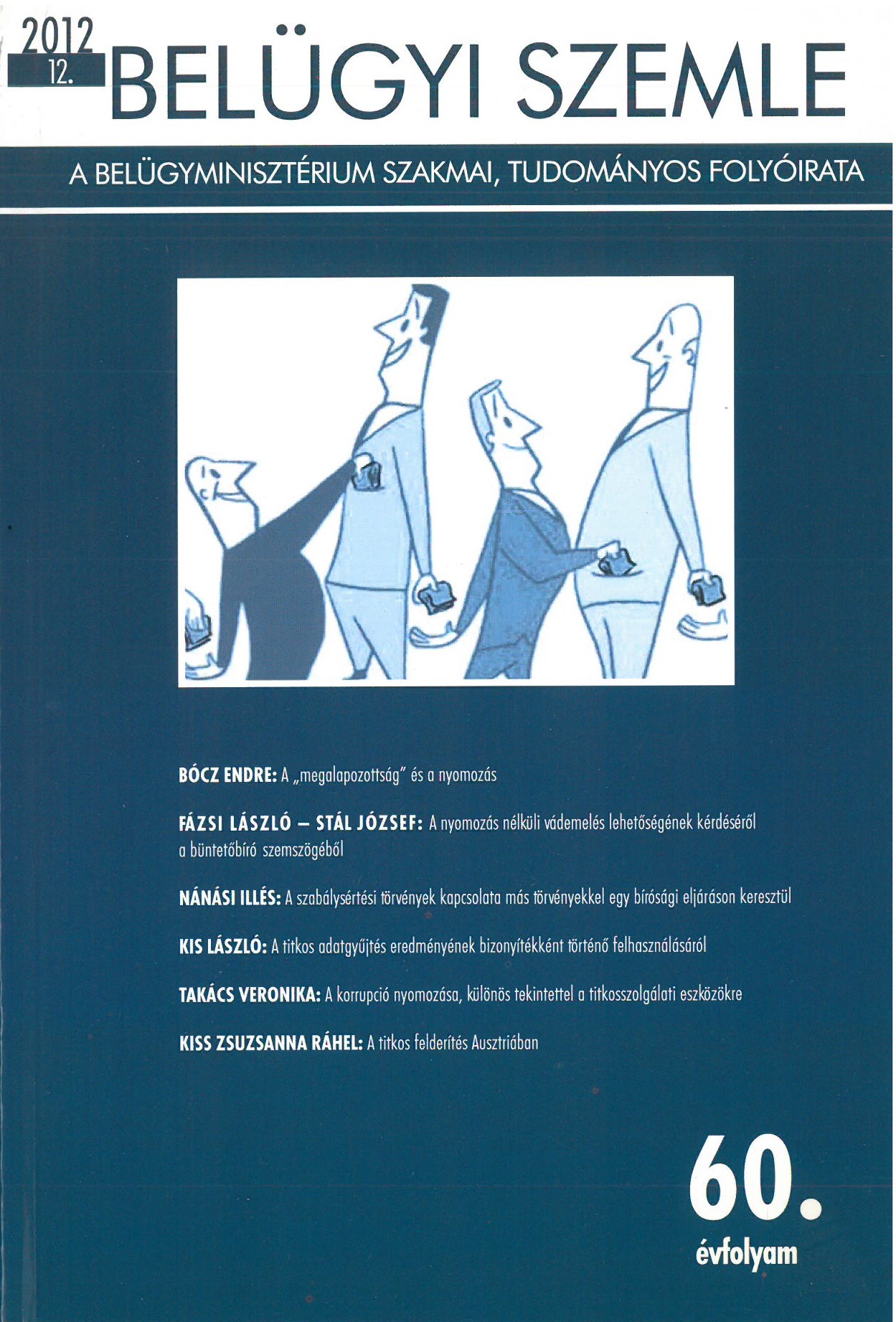Keywords
suspicion
investigation
forensics
investigation
forensics
How to Cite
“Well-foundedness” and investigation . (2012). Academic Journal of Internal Affairs, 60(12), 5-30. https://doi.org/10.38146/bsz-ajia.2012.v60.i12.pp5-30
Abstract
Providing a thorough analysis of Hungarian criminal procedure law, the author investigates the precise meaning and content of the requirement for the suspicion to be “well-founded”.
References
.

This work is licensed under a Creative Commons Attribution-NonCommercial-NoDerivatives 4.0 International License.
Copyright (c) 2025 Academic Journal of Internal Affairs
Downloads
Download data is not yet available.
Similar Articles
- József Répás, The role of anti-forensics techniques in the expert examination of highly automated vehicles , Academic Journal of Internal Affairs: Vol. 71 No. 9 (2023)
- Miklós Angyal, Systematic crime scene investigation-triggered lessons for problem oriented policing: the case study of shootings in a Hungarian university , Academic Journal of Internal Affairs: Vol. 61 No. 10 (2013)
- Éva Kovács-Széles, István Almási, Ákos Balaskó, Csaba Bíró, Károly Bodor, Csilla Csöme, Izabella Kakuja, Zsuzsanna Kreitz, Kornél Papp, Csaba Tóbi, József Volarics, How to respond a crime scene contaminated with radioactive material? , Academic Journal of Internal Affairs: Vol. 68 No. 3. ksz. (2020): Special Issue
- Éva Kovács-Széles, István Almási, Ákos Balaskó, Csaba Bíró, Károly Bodor, Csilla Csöme, Izabella Kakuja, Zsuzsanna Kreitz, Kornél Papp, Csaba Tóbi, József Volarics, How to respond to a crime scene contaminated with radioactive material? , Academic Journal of Internal Affairs: Vol. 68 No. 12 (2020)
- Dávid Petrétei, The Future of the Criminalistics, the Criminalistics of the Future , Academic Journal of Internal Affairs: Vol. 62 No. 10 (2014)
- Dávid Petrétei, Theoretical and practical notes on crime scene technology , Academic Journal of Internal Affairs: Vol. 61 No. 10 (2013)
- Bettina Zsiros, Excessive Evidence, as an Anomaly of Searching for Truth in Criminal Proceedings , Academic Journal of Internal Affairs: Vol. 70 No. 4 (2022)
- Csongor Herke, The forensic Aspects of Artificial Intelligence , Academic Journal of Internal Affairs: Vol. 69 No. 10 (2021)
- Géza Finszter, László Korinek, Tracing the footsteps of the lost suspicion , Academic Journal of Internal Affairs: Vol. 66 No. 3 (2018)
- Bálint Kolozsi, International cooperation in criminal matters, Joint Investigation Team involving Hungary, Germany, Romania , Academic Journal of Internal Affairs: Vol. 70 No. 2 (2022)
You may also start an advanced similarity search for this article.
Most read articles by the same author(s)
- Endre Bócz, Interrogation, forced interrogation , Academic Journal of Internal Affairs: Vol. 61 No. 5 (2013)
- Endre Bócz, Nyiri Sándor: The Past Is Always with Us , Academic Journal of Internal Affairs: Vol. 60 No. 6 (2012)
- Endre Bócz, Tactics, interrogation, recording , Academic Journal of Internal Affairs: Vol. 63 No. 2 (2015)
- Endre Bócz, On the so called “Roma serial killings” , Academic Journal of Internal Affairs: Vol. 65 No. 7-8 (2017)
- Endre Bócz, Discipline Law Enforcement , Academic Journal of Internal Affairs: Vol. 67 No. 6 (2019)
- Endre Bócz, Notes on the so called Roma murder case , Academic Journal of Internal Affairs: Vol. 63 No. 11 (2015)
- Endre Bócz, Data collection, reconnoitering and investigation: Notes on attitudes and terminology , Academic Journal of Internal Affairs: Vol. 59 No. 4 (2011)
